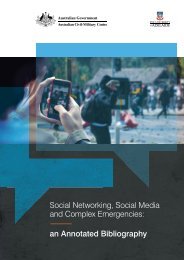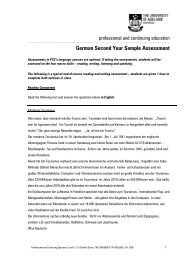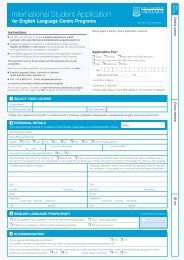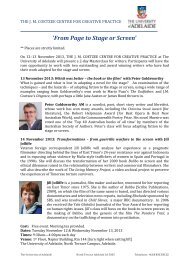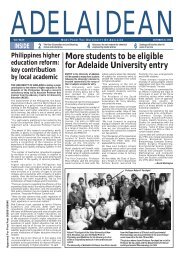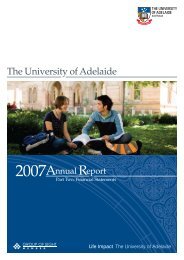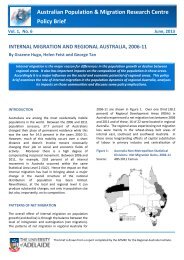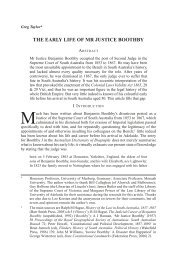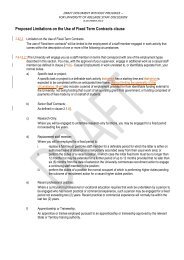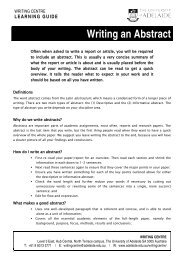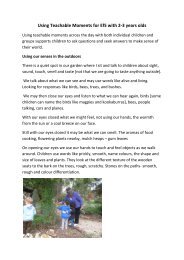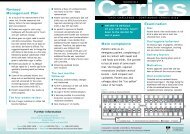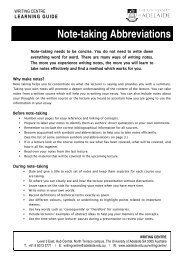Harvard Referencing Guide - University of Adelaide
Harvard Referencing Guide - University of Adelaide
Harvard Referencing Guide - University of Adelaide
You also want an ePaper? Increase the reach of your titles
YUMPU automatically turns print PDFs into web optimized ePapers that Google loves.
<strong>Harvard</strong> <strong>Referencing</strong> <strong>Guide</strong><br />
Notes<br />
And / &<br />
� For in-text references, use 'and' between names in the text and '&' between names in brackets.<br />
� Use ‘&’ between authors’ names in the reference list.<br />
Authors<br />
� An author is someone who has written a particular text, such as a book or journal article.<br />
� An editor is someone who has compiled a text, such as a dictionary, or a book to which several authors have<br />
contributed.<br />
� For two authors with the same family name, writing in the same year, include their initials in the in-text<br />
reference. e.g. E Peters 2007, P Peters 2007. Give complete reference details as usual in the reference list<br />
and list them alphabetically in order <strong>of</strong> the family name followed by the authors’ initials.<br />
� Use the name <strong>of</strong> the first author and then 'et al.' for 4 or more authors in in-text references. Give all the<br />
authors in the reference list entry.<br />
doi<br />
� Some referencing styles use a DOI (digital object identifier) for journal articles, but this is not currently part <strong>of</strong><br />
<strong>Harvard</strong> style. Check with your lecturer if this is required. If you need to include it, put it at the end, after the<br />
journal article page numbers.<br />
Dates<br />
� Website with no date – write n.d.<br />
� Two books or articles written in the same year – use the letters ‘a’ and ‘b’ in the text and in the reference list.<br />
e.g. Smith 2000a, Smith 2000b.<br />
Editions<br />
� If a book has several editions, write the number <strong>of</strong> the edition you have used. N.B. This is not the same as the<br />
printing or reprinting date. First editions do not say ‘first edition’, but second and subsequent editions will tell<br />
you which edition it is.<br />
Place <strong>of</strong> publication<br />
� Book with many places <strong>of</strong> publication – choose the first.<br />
� Book with no place <strong>of</strong> publication – write n.p.<br />
Pagination<br />
� Use p. when referring to one page and pp. for more than one page.<br />
� Give page numbers in the text whenever you quote or paraphrase.<br />
Multiple and secondary sources<br />
� For more than one source at one place in the text, put the references in brackets in alphabetical order,<br />
separated by a semicolon (e.g. Brown 2003; Miller 2009; Smith 2001).<br />
� For secondary sources, give both sources in the text (e.g. Smith 2001 in Wright 2004) and only put the book<br />
you have physically used in the reference list (e.g. Wright, IM 2004, How to quote, Book Press, <strong>Adelaide</strong>).<br />
Special exceptions<br />
� For classics (e.g. Virgil), give the line number and the date <strong>of</strong> the edition you have used in the reference list<br />
but not in the text.<br />
� Details <strong>of</strong> dictionaries, plays and poetry are not usually included in the reference list, unless you are studying a<br />
text and need to give publication and edition details.<br />
All the examples in this style sheet are based on:<br />
Commonwealth <strong>of</strong> Australia 2002, Style manual for authors, editors and printers, 6th edn, rev. Snooks & Co., John Wiley &<br />
Sons, Milton, Queensland.<br />
Please see that book for examples <strong>of</strong> other types <strong>of</strong> reference not included here.<br />
30 March 2012<br />
Writing Centre, The <strong>University</strong> <strong>of</strong> <strong>Adelaide</strong> 6



